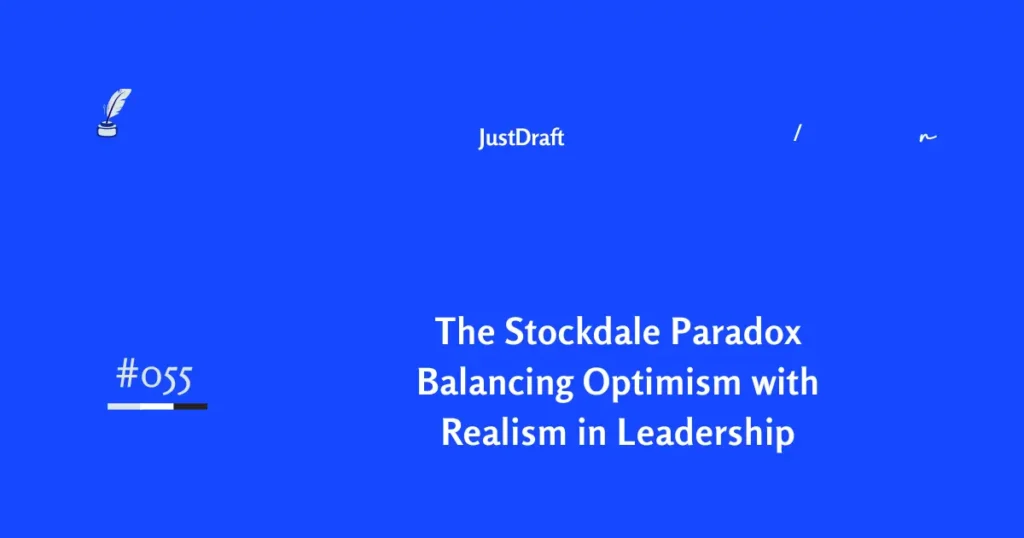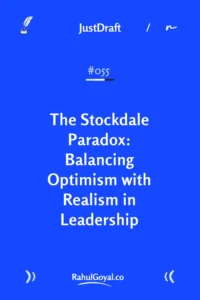The Stockdale Paradox: Balancing Optimism with Realism
You know what kills most businesses during tough times? It’s not pessimism. It’s blind optimism.
I learned this from one of the most counterintuitive leadership lessons I’ve encountered, the Stockdale Paradox. And it changed how I think about resilience.
One Topic: The Stockdale Paradox Balancing Optimism with Realism
The Story That Started It All
Admiral James Stockdale spent 7.5 years as a prisoner of war in Vietnam’s “Hanoi Hilton.” Tortured over 20 times. Four years in solitary confinement. Two years in leg stocks.
When author Jim Collins asked him who didn’t make it out, Stockdale’s answer shocked him: “The optimists.”
The ones who said, “We’ll be out by Christmas.” Then Christmas passed. “We’ll be out by Easter.” Easter came and went. “Definitely by Thanksgiving.”
They died of broken hearts.
But Stockdale wasn’t a pessimist either. He never doubted he’d get out. He just refused to lie to himself about his current reality.
That’s the paradox: You must maintain unwavering faith that you will prevail in the end, while simultaneously confronting the most brutal facts of your current reality.
Why This Matters in Business
I’ve seen this play out in countless businesses. The CEO who keeps saying “We’ll be profitable next quarter” for eight consecutive quarters. The startup founder who ignores declining user metrics because they believe in their vision. The manager who sugarcoats layoffs as “restructuring opportunities.”
They’re all falling into the optimist trap.
When Collins studied 1,435 businesses over 30 years, he found something remarkable. Every single one of the 11 companies that made the leap from good to great faced significant adversity. And 100% of them embraced the Stockdale Paradox.
The data backs this up. Teams led by leaders who balance optimism with realism are 80% more adaptive, 21% more productive, and 22% more profitable than those led by pure optimists or pessimists.
The Two Parts You Need to Get Right
Part 1: Unwavering Faith
This isn’t hope. It’s absolute commitment to prevail, no matter how long it takes. Notice what Stockdale didn’t say, he never mentioned a timeline. He didn’t say “I’ll be out by Christmas.” He said “I will get out.”
In business, this means believing you’ll succeed while refusing to set false timelines. You don’t promise “profitability by Q3” without evidence. You commit to doing whatever it takes to build a profitable business, period.
Part 2: Brutal Facts
This is where most leaders fail. They soften the language. “We’re facing headwinds” instead of “Revenue is down 30%.” “Market challenges” instead of “Our competitor is eating our lunch.”
Confronting brutal facts means:
- No sugarcoating
- No minimizing problems
- No wishful thinking
- No false narratives
When I face a tough situation now, I ask myself: Am I seeing reality clearly, or am I seeing what I want to see?
Real Examples That Prove It Works
Kroger faced Walmart entering the grocery business. The brutal fact? Walmart had better logistics, lower prices, and overwhelming scale. The fatal optimistic response would’ve been “Our loyal customers won’t switch.”
Instead, Kroger confronted reality and focused on what Walmart couldn’t replicate – fresh food expertise and community relationships. They didn’t just survive; they beat Walmart in groceries.
Stripe, now valued at $95 billion, explicitly embraces this paradox. A former engineering manager explained it perfectly: You need optimism when you’re “transforming the global payments system with 200 people” while “things are constantly on fire.” But you can’t ignore the fires.
How to Apply This Tomorrow
Start with three questions:
- What brutal fact am I avoiding right now? Write it down. No softening. No “but.”
- What’s my unwavering commitment? Not “We’ll fix this by March.” Instead, “We will build a sustainable business, whatever it takes.”
- Am I confusing faith with timeline? Faith is about the destination. Timelines are often wishful thinking disguised as strategy.
Here’s what this looks like practically:
In your next team meeting, try this: “Here’s our reality, revenue is down 25%, and we have six months of runway. And here’s what I know with certainty, we will figure this out and emerge stronger. Now let’s talk about what we’re going to do.”
No false hope. No false timelines. Just brutal facts plus unwavering faith.
In Summary
The Stockdale Paradox isn’t about being positive or negative. It’s about being both realistic and committed simultaneously.
Stockdale credited Stoic philosophy, particularly Epictetus for his survival. The Stoics understood something we often forget:
You can’t control what happens to you, but you can control how you respond. And the best response is seeing reality clearly while refusing to accept defeat.
As Stockdale put it: “You must never confuse faith that you will prevail in the end with the discipline to confront the most brutal facts of your current reality, whatever they might be.”
That’s not just a survival strategy. It’s a winning strategy.
The next time you face a crisis, remember: The optimists who set false timelines die of broken hearts. The pessimists who accept defeat ensure failure. The realists with unwavering faith? They prevail.

Interested in travel, read last week’s LensLetter newsletter about Photography Gears to Check During Black Friday Sale.
Read last week’s JustDraft about Feedback Guide for Managers.
Two Quotes to Inspire
True leadership isn’t choosing between optimism and realism, it’s having the courage to hold both truths simultaneously without confusion.
The graveyard of business is filled with optimists who set false timelines and pessimists who accepted defeat. The survivors are realists with unwavering faith.
One Passage From My Bookshelf
We will always be tempted to let our emotions take over. To let fear or frustration or confusion dominate us. But the Stoics remind us that we can choose to see clearly. We can choose to respond with reason. When we accept the obstacles in our path, they become the way forward. We stop feeling wronged and start seeing opportunity. The world is full of difficult moments, but none of them have to break us. What matters is how we respond, how we hold our ground, and how we keep moving.
📚 From The Obstacle Is the Way by Ryan Holiday

